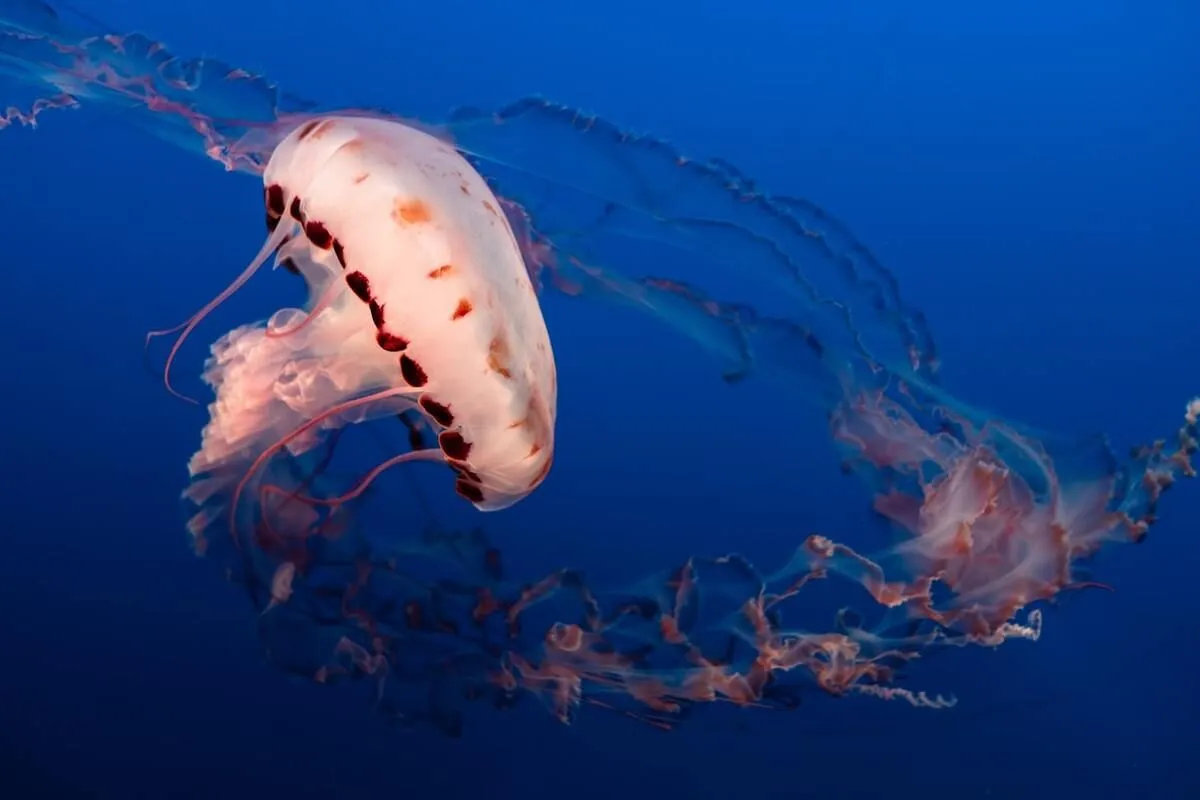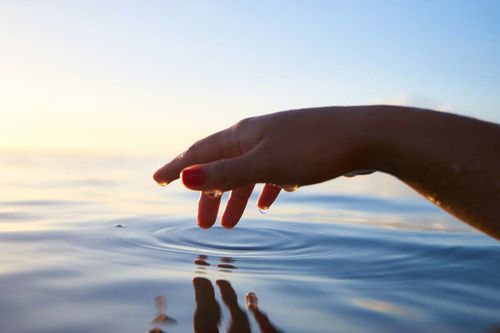FOR ALL AGES
Jellyfish, while sometimes very scary, are also one of the coolest and most unique animals on our planet.
We've put together this list of fascinating facts that will leave you wanting to tell all of your friends about these strange creatures. From jellyfish with an immortal life cycle to jellyfish being blasted into space, these jellyfish facts for kids will blow you away.
If you like our list of jellyfish facts and want more fun animal facts, check out our shark facts and chihuahua facts.
These fun facts about jellyfish are all you need to know about jellyfish and their crazy history on Earth.
1. Jellyfish aren't fish at all. These mysterious creatures are actually gelatinous invertebrates, which means they have no spine and are like jelly!
2. There could be over 300,000 species of jellyfish out there that we don't know about yet. Across the world so far, we have discovered over 2000 different types of jellyfish, but scientists think that there are many more living in our oceans.
3. A group of jellyfish can be called a bloom, a swarm or a smack. We like smack the best because we imagine that's exactly what it would feel like if you came across a group of jellyfish and their nasty stingers! Blooms can have just a few jellyfish or thousands in them.
4. Jellyfish are older than dinosaurs! There are fossils from over 500 million years ago, and scientists believe that they might have even been around for 700 million years, making them hundreds of million years older than dinosaurs.
5. There are more than 25 types of jellyfish that humans can eat and they are very commonly eaten in places like China, Korea, Indonesia, Thailand, Myanmar, and The Philippines.
6. Another name for a jellyfish is a Medusa. This is because their round shape and tentacles look like Medusa from Greek mythology, who had snakes for hair.
From wild jellyfish characteristics and jellyfish food to the parts of a jellyfish and jellyfish colors, we've got the coolest biology facts you need to know.
7. Baby jellyfish are called 'ephyrae'. The jellyfish life cycle starts from an egg which turns into larvae, then into a polyp, and then into ephyrae before finally maturing into the medusa stage, which is the name for an adult jellyfish.
8. Jellyfish only sting other jellyfish species, because their stingers don't fire upon their own kind.
9. The main jellyfish parts of these fully grown animals are the bell-shaped body, the oral arms that bring their food to their mouth, and up to 15 tentacles.
10. Jellyfish can be made of anywhere between 85% and 98% water, so if you ever see one washed up on the beach they will almost start to vanish as their water dries up.
11. Jellyfish don't have a brain, a heart or lungs! As important as these organs are to us, jellyfish can survive without them. As they can absorb oxygen through their very thin skin, they don't need lungs. Jellyfish also don't have any use for a heart, because they have no blood, and instead of a brain, jellyfish have a set of nerves that let them move.
12. Most jellyfish species only live for less than a year and some only live for a couple of days.
13. Jellyfish are most closely related to corals and sea anemones and they are a part the same animal group.
14. Some jellyfish have crazy long tentacles. The largest jellyfish in the world, called the lion's mane has tentacles that can reach the same length as a blue whale, at 120ft long! Some jellyfish tentacles can be as short as 0.20 inches.
15. Jellyfish are a type of plankton, which comes from the Greek word meaning "to drift". Their movement depends on the direction of ocean currents as they can't swim very well.
16. No matter how long their tentacles are, jellyfish don't often get tangled with each other because they are so slippery. If they ever do lose a tentacle, many can easily grow them back.
17. Some species of jellyfish are bioluminescent, meaning they glow with bright colors in the dark. This is used to scare off predators, but it is also very pretty to look at.
18. Jellyfish have to poop out their food in the same place where they eat because they can't float if the food is still in their bodies.
19. The diet of a jellyfish includes crabs, fish, shrimp, plants, and sometimes even smaller jellyfish.
20. Some jellyfish actually have "teeth" that are very thin hairs that they use to pull and chomp up their food.
21. Jellyfish can use their mouth to move around the water by squirting a stream of water from it.

Here's everything you need to know about where and how jellyfish live.
22. There are hundreds of jellyfish species in every single ocean all over the world.
23. Most jellyfish live along coastal areas, but some live deep in the ocean or even in the freezing Arctic waters.
24. Most blooms form in the saltier areas of the ocean.
25. No "true" jellyfish species live in freshwater.
26. Pollution from things like oil spills are very harmful to jellyfish as the chemicals get absorbed into their skin and this can stop them from having babies and shorten their life.
27. A super unique jellyfish characteristic is that while most marine animals struggle to survive in our warming oceans, the easy adaptation of jellyfish to heat means they can survive.
28. Blooms usually form where ocean currents meet and if there a strong winds, hundreds or even thousands of jellyfish can end up on the beach. Jellyfish can also be found travelling alone.
These wild jellyfish facts will leave you shocked knowing that they are actually real!
29. There is an immortal jellyfish. These animals can go from being an adult jellyfish right back to being a polyp and start the life cycle again, so they can technically live forever!
30. 60,000 jellyfish have been sent to space.
31. In China, jellyfish are used as medicine. They are said to help with improving memory and heart issues.
32. Jellyfish have some pretty crazy names. Some of the coolest jellyfish names include fire jellies, cannonball jellyfish, Portuguese man-of-war, and even purple people eaters.
33. Sometimes little fish use jellyfish as hiding spots, as their stingers protect them from predators. Crabs also sometimes sit on top of jellyfish if they don't want to swim.
34. The famous tale about peeing on a jellyfish sting is actually a myth and can even end up causing more pain.
35. Even though many marine animals like sea turtles and sunfish eat jellyfish, jellyfish populations are growing so fast they're starting to take over the ocean!

These jellyfish fun facts are sure to freak you out and will make sure you stay as far away as possible from these crazy critters, but will also leave you amazed.
36. The Australian box jellyfish is the most venomous marine animal in the entire world and has the deadliest sting of all jellyfish! Different types of box jellyfish also live in warm waters along coasts all over the world, so watch out for those nasty jellies.
37. Irukandji jellyfish are the smallest jellyfish in the world and can be smaller than a penny. But don't be fooled by their size, they are one of the deadliest jellyfish on earth!
38. You can get stung by a jellyfish without touching their tentacles. This happens if they release little bits of their body into the sea that float around and touch your skin.
39. Most stings happen when humans accidentally brush by a jellyfish.
40. A jellyfish's tentacles can have millions of very small stinging cells. These stinging cells release toxin into a prey, so when a human brushes a jellyfish, it stings because these toxins are going into our skin!
Here at Kidadl, we have carefully created lots of interesting family-friendly facts for everyone to enjoy! If you liked our suggestions for jellyfish facts then why not take a look at these calico cat facts, or clownfish facts?
Read The Disclaimer
At Kidadl we pride ourselves on offering families original ideas to make the most of time spent together at home or out and about, wherever you are in the world. We strive to recommend the very best things that are suggested by our community and are things we would do ourselves - our aim is to be the trusted friend to parents.
We try our very best, but cannot guarantee perfection. We will always aim to give you accurate information at the date of publication - however, information does change, so it’s important you do your own research, double-check and make the decision that is right for your family.
Kidadl provides inspiration to entertain and educate your children. We recognise that not all activities and ideas are appropriate and suitable for all children and families or in all circumstances. Our recommended activities are based on age but these are a guide. We recommend that these ideas are used as inspiration, that ideas are undertaken with appropriate adult supervision, and that each adult uses their own discretion and knowledge of their children to consider the safety and suitability.
Kidadl cannot accept liability for the execution of these ideas, and parental supervision is advised at all times, as safety is paramount. Anyone using the information provided by Kidadl does so at their own risk and we can not accept liability if things go wrong.
Kidadl is independent and to make our service free to you the reader we are supported by advertising.
We hope you love our recommendations for products and services! What we suggest is selected independently by the Kidadl team. If you purchase using the buy now button we may earn a small commission. This does not influence our choices. Please note: prices are correct and items are available at the time the article was published.
Kidadl has a number of affiliate partners that we work with including Amazon. Please note that Kidadl is a participant in the Amazon Services LLC Associates Program, an affiliate advertising program designed to provide a means for sites to earn advertising fees by advertising and linking to amazon.
We also link to other websites, but are not responsible for their content.
Was this article helpful?



Browse Category



We’ll send you tons of inspiration to help you find a hidden gem in your local area or plan a big day out.



Check your inbox for your latest news from us. You have subscribed to:
Remember that you can always manage your preferences or unsubscribe through the link at the foot of each newsletter.